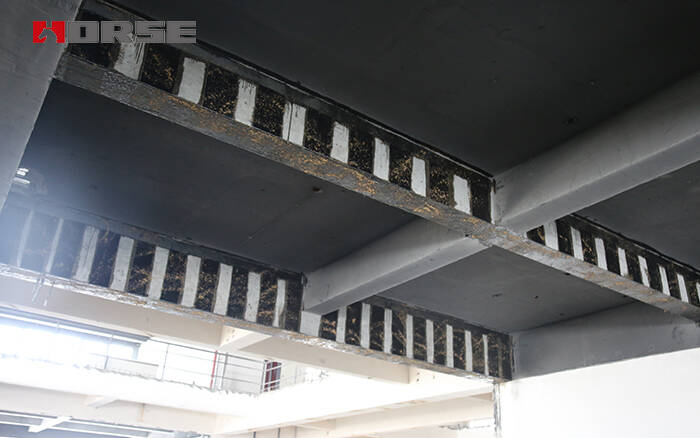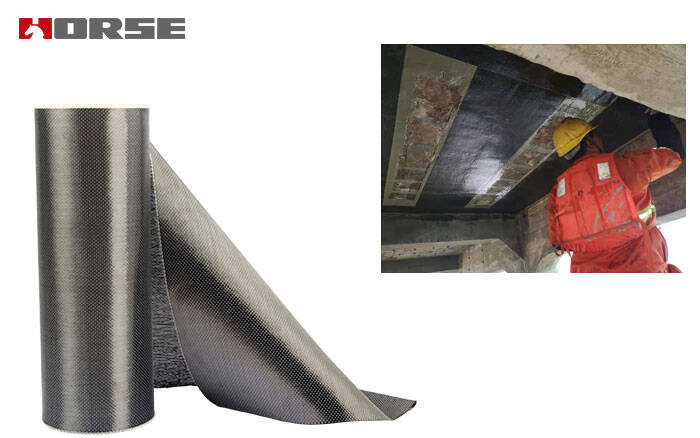Solutions
Horse Construction offers full range of structural strengthening materials with technical supports, documentation supports, products supports, project supports.
The application of externally bonding carbon fiber wrap in strengthening the structure of concrete

At present, in the engineering structural strengthening and retrofitting market, the most widely used reinforcement technology is the externally bonded unidirectional carbon fiber wrap. The reason is certainly related to the advantages of this material itself. For example, it has light weight, high strength, acid and alkali resistance, does not occupy the original building space, simple construction, and almost no wet work. Therefore, in various reinforcement and reconstruction occasions, there will always be a lot of carbon fiber reinforcement schemes involved in the construction, but carbon fiber as a material for external reinforcement, although there are many advantages, there are also some weaknesses that are difficult to control. The most important thing is in the reinforcement design. At times, it is difficult to assess the possible risks of fire, vandalism, or other accidents to this material.
Carbon fiber wrap used for reinforcement of load-bearing structures is generally woven from unidirectionally arranged filament bundles (yarn bundles). The quality of its performance is not only related to the weaving method, but also mainly depends on the quality of the carbon fiber tow used. Therefore, when choosing carbon fiber wrap, we should first check whether the type, grade and model of the tow meet the requirements of the load-bearing structure.
1 Design regulations
1.1 General regulations
When using bonded carbon fiber wraps to reinforce the concrete structure, the carbon fiber wraps should be pasted on the surface of the component through the corresponding bonding materials so that the carbon fiber wraps can bear the tensile force and coordinate with the deformation of the concrete to receive the force together. Paste carbon fiber wraps in the tension area of beams and plate members for bending reinforcement, and the fiber direction should be consistent with the tension direction of the reinforcement. Adopt closed pasting, U-shaped pasting or side pasting to strengthen beams and columns under shear. The fiber direction should be perpendicular to the axial direction of the components. Adopt enclosed paste to strengthen the column for seismic reinforcement, and the fiber direction should be perpendicular to the column axis.
When there is a reliable basis, carbon fiber wraps can also be used to strengthen concrete structural members in other forms and other stress conditions. When using pasted carbon fiber wraps to reinforce concrete structures, the ultimate state design method based on probability theory should be used in accordance with the current relevant national standards to carry out the limit state calculation of the bearing capacity and the check calculation of the normal service limit state. Rebar and concrete materials should determine their corresponding material strength design indicators according to the actual strength obtained by the test and the current relevant national standards. Carbon fiber wraps should be based on the strain when the component reaches the limit state, and the corresponding stress should be determined according to the linear elastic stress-strain relationship. . Carbon fiber wrap should take the ultimate tensile strength of not less than 95% guarantee rate provided by the manufacturer as the standard value of tensile strength fcfk, and the ultimate strain of carbon fiber wrap should be the standard value of tensile strength fcfk divided by the elastic modulus Ecf .
When using pasted carbon fiber wraps to reinforce a structure or component, the possible impact on other components or other properties of the structure after the reinforcement should be considered. When using bonded carbon fiber wraps for structural reinforcement, it is advisable to remove the live load acting on the structure. If the reinforcement cannot be carried out under complete unloading conditions, the influence of the secondary force should be considered. During bending reinforcement and shear reinforcement, the actual concrete strength grade of the reinforced concrete structure and components shall not be lower than C15. When using sealed and pasted carbon fiber wraps to reinforce concrete columns, the concrete strength level should not be lower than C10.
1.2 General structural requirements
When the carbon fiber wrap needs to be pasted around the corner of the component along its fiber direction, the radius of curvature of the outer surface at the corner of the component should not be less than 20 mm. The lap length of the carbon fiber wrap along the fiber stress direction should not be less than 100mm. When multiple or multiple layers of carbon fiber wrap are used for reinforcement, the lap positions of each or each layer of carbon fiber wrap should be staggered. In order to ensure that the carbon fiber wrap can work reliably with the concrete, additional anchoring measures should be taken when necessary.

2 Construction regulations
Reinforcing concrete structures with carbon fiber wraps should be undertaken by a professional construction unit familiar with the construction technology of this technology, and there should be a reinforcement plan and construction technical measures. The construction process should be: construction preparation-concrete surface treatment-preparation and coating of bottom resin-preparation of leveling materials and leveling treatment of unevenness-preparation and coating of impregnating resin or paste resin-pasting of carbon fiber wrap. In the construction process of surface protection, in addition to considering the impact of ambient temperature and humidity on the curing of the resin, the supporting resin should be used for construction or reasonable measures should be adopted to ensure the stability of the material. When preparing the resin, it should be weighed according to the proportion specified in the product instructions and placed in a container, and stirred with a mixer until the color is uniform. There should be no oil and impurities in the mixing container and on the mixer. The mixing amount of the resin should be determined according to the actual ambient temperature on site, and the use time should be strictly controlled as required. Before construction, you should carefully read the design and construction drawings, draw up a construction plan and construction plan according to the actual conditions of the construction site and the concrete to be reinforced, and make pre-construction preparations for the used carbon fiber wraps, supporting resins, and machinery.
Externally bonded carbon fiber wrap to strengthen the structure can not only solve the technical problems urgently needed in the project, but also have better comprehensive benefits. The practice of the reinforcement project proved that in the reinforcement project, the construction period, quality, and cost are optimized by using carbon fiber wrap to strengthen the structure, and the structure is reasonably stressed, and the purpose of safety, reliability, economy and application is achieved. The engineering technical problems were solved, and better comprehensive benefits were received. Therefore, the application of carbon fiber wrap to strengthen concrete structures in engineering will become more and more extensive.
You can find anything here you are in need of, have a trust trying on these products, you will find the big difference after that.

High strength, unidirectional carbon fiber fabric pre-saturated to form a carbon fiber reinforced polymer (CFRP) fabric used to strengthen structural concrete elements.

High strength, unidirectional carbon fiber sheet pre-saturated to form a carbon fiber reinforced polymer (CFRP) sheet used to strengthen structural concrete elements.

Two-components modified epoxy resin adhesive, with high quality plastic tube, double cartridge package for anchoring